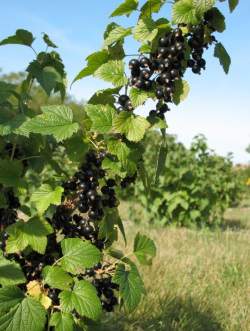Black Currants – Ribes nigrum
Black Currant Update 2014-2017
Black Currant Production Notes 2009-12
Black currants are delicious, nutritious and …..delicious! (Their flavor can, however, be an acquired taste.)
Black currants are very widely grown in many European countries with written reports of their use dating from the 1500-1600s. In modern times, commercial plantings and the use of black currants were invigorated by the spread of events leading to World War II. England, in particular, was concerned about its ability to obtain vitamin C-rich fruits, which became scarce in WWI, and therefore encouraged black currant production. Today, currants remain very popular in products like juice, jam, tea, desserts, wine and liqueurs.
In 1899, over 12,000 acres of black currants were produced commercially in the US1. Black currants fell out of favor after commercial cultivation was banned by Congress in the 1910s in response to concerns by the lumber industry to a disease new to North America. The disease, called white pine blister rust (WPBR), harms white pines if susceptible currants are grown closer than 1000 feet to the trees. Today the US ban has been lifted. In New York and Connecticut as well as British Columbia, Canada, and other places, commercial production is growing. The disease is not as widespread as it was in the past and there are black currant cultivars that are resistant or immune to the disease – which you should plant if you live near white pines. Resistant varieties include: ‘Titania’, ‘Minaj Smyriou’, ‘Consort’, ‘Crusader’ and ‘Coronet’ (the last three varieties cannot pollinate each other).
For currant-lovers, a day without currants could be said to be like a day without sunshine! By weight, black currants contain three to four times more vitamin C than oranges and they are rich in minerals such as calcium, phosphorus and potassium, phytonutrients and essential fatty acids. The levels of antioxidants are twice that of blueberries2.
Black currant flavor is often remarked upon as being “unique” or “strong” without any further explanation. Berries are high in vitamin C and so they are tart, but they are also sweet when ripe. What is unique though, is a distinct resinous or piney flavor in the berries. A big surprise! But even more surprising is the odor of the leaves and branches early in the year: they can be said to have a ‘catty’ odor that fades as the summer progresses. But! After repeated tasting to determine ripeness (which is about 3-4 weeks after the color changes), you may fall in love with the fresh flavor. Cooked products such as jelly or mixed fruit cobblers only taste rich and fruity while wine, juice or cordials may carry a hint of the resinous character that millions of people around the world appreciate. Once you find you like currants, you may not be able to go without!

Plant rooted cuttings deeply, with the root ball 3-4 inches below the soil surface. Prune back to three or four buds to encourage shrubby growth and expect fruit in the 3rd year. One, two and three-year-old shoots bear fruit, so leave a selection while you thin for air movement within the plant each year. Four-year-old shoots should be pruned out in very early spring.
Look for a variety that is resistant to powdery mildew, as this will be your biggest problem in North Dakota. ‘Titania’ is resistant to mildew as well as to WPBR – it is a favorite variety here. WPBR should not bother your currant plants too much as it usually develops after harvest, but in years of wet weather, you may see it earlier than you’d like.
- “Currants”. UMass Extension Outreach.
- New Zealand Blackcurrant Co-operative. www.nzblackcurrants.com


